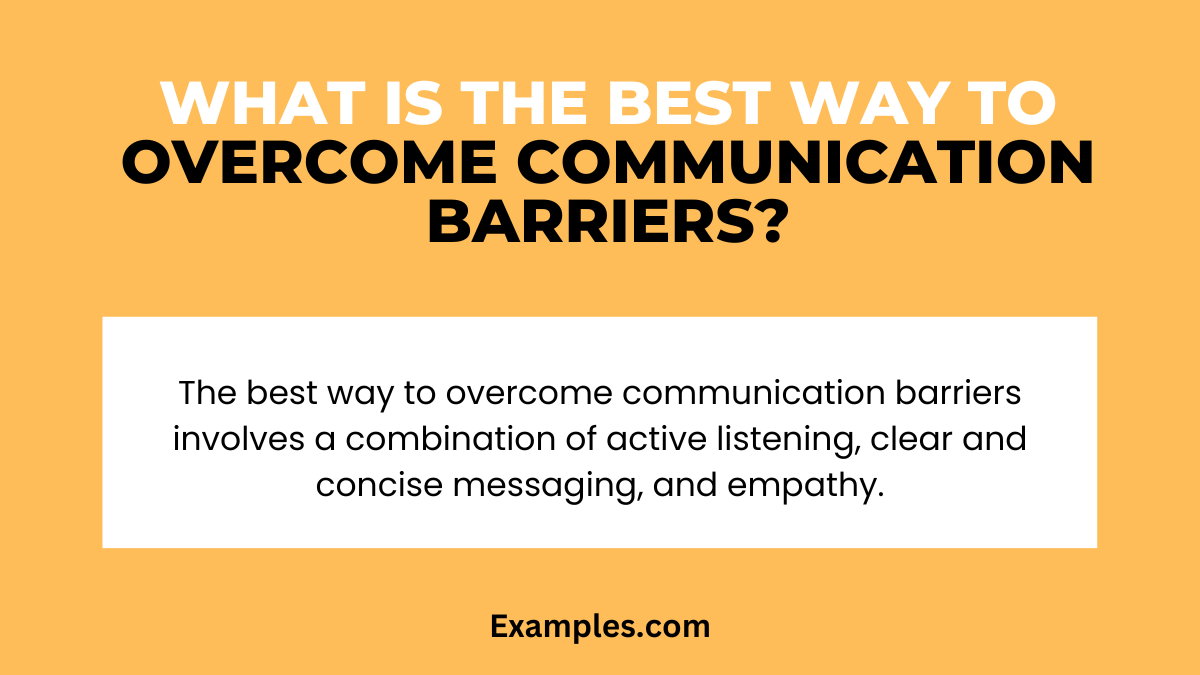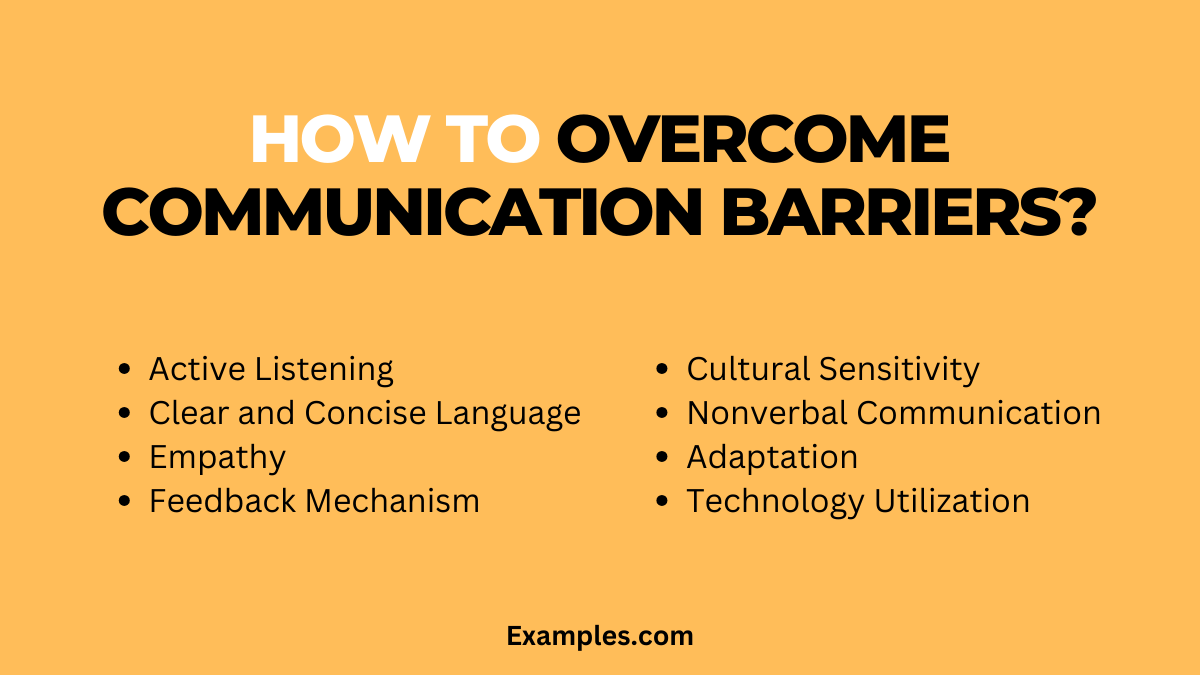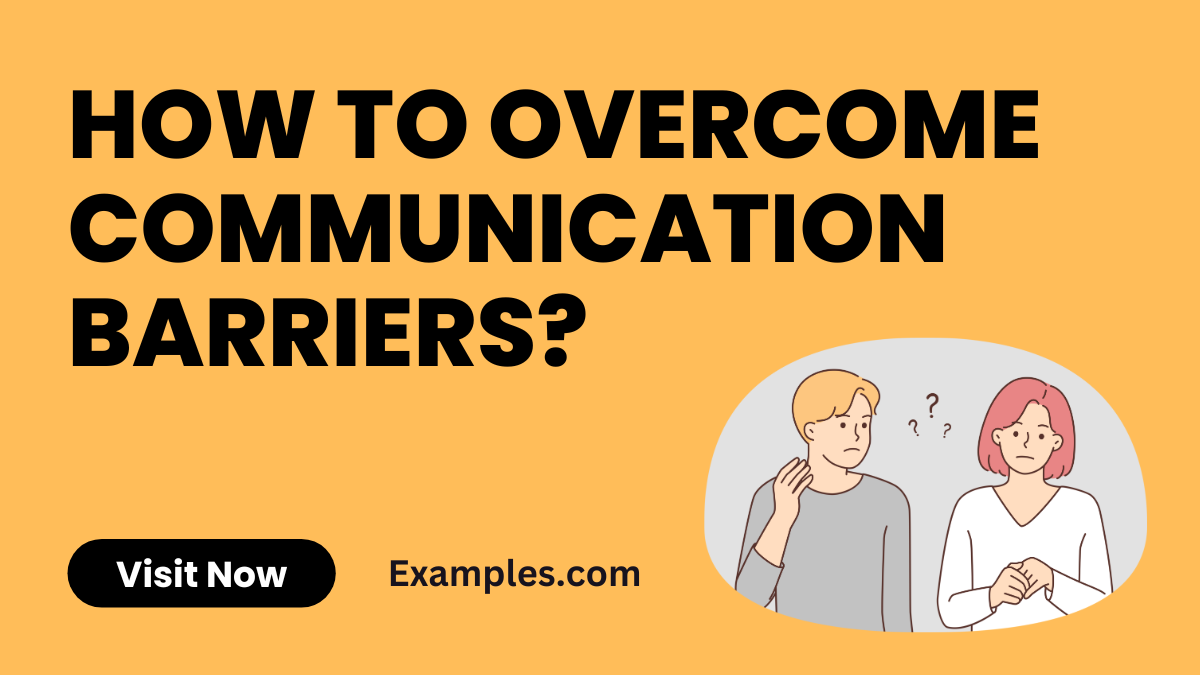How to Overcome Communication Barriers – 9+ Examples
Overcoming communication barriers is essential for effective interaction in various settings, be it personal, professional, or academic. This guide delves into the definition, examples, origins, and history of communication barriers. It includes practical tips and strategies on how to navigate these obstacles effectively. You’ll find examples demonstrating common communication barriers and advice on overcoming them, enhancing understanding, and fostering better connections. Understanding these barriers is the first step in developing more effective and meaningful communication.
What is the Best Way to Overcome Communication Barriers?

The best way to overcome communication barriers involves a combination of active listening, clear and concise messaging, and empathy. Active listening ensures a deeper understanding, while concise messaging helps in reducing misunderstandings. Empathy allows communicators to connect on a more personal level, bridging gaps in perception and background. Additionally, being aware of nonverbal cues and adapting communication styles to suit different audiences can significantly improve the effectiveness of interactions.
How to Overcome Communication Barriers?

To effectively overcome communication barriers, consider the following steps:
- Active Listening: Engage in active listening to fully understand the message.
- Clear and Concise Language: Use simple, direct language to avoid misunderstandings.
- Empathy: Show understanding of others’ perspectives.
- Feedback Mechanism: Encourage and utilize feedback to ensure message clarity.
- Cultural Sensitivity: Be aware of and respectful towards cultural differences.
- Nonverbal Communication: Pay attention to body language and tone.
- Adaptation: Be willing to adapt your communication style as needed.
- Technology Utilization: Leverage technology to bridge distance barriers.
- Continuous Improvement: Regularly seek ways to improve communication skills.
Examples of How to Overcome Communication Barriers
Overcoming communication barriers is crucial in daily interactions. This guide highlights practical examples with strategies such as active listening, clear language use, and empathetic understanding to bridge gaps in communication.
- Using Simple Language How to Communicate: “Instead of technical terms, let’s use everyday language for better understanding.” Explanation: Simplifying language helps in making complex ideas more accessible and understandable.
- Active Listening How to Communicate: “I hear what you’re saying. You’re concerned about…” Explanation: Repeating back what’s heard to show understanding and validate the speaker’s points.
- Body Language Awareness How to Communicate: “Your body language seems tense. Is everything okay?” Explanation: Observing and commenting on nonverbal cues can clarify unspoken feelings.
- Providing Written Summaries How to Communicate: “Let me email you a summary of our discussion for your reference.” Explanation: Offering written summaries can help reinforce verbal communication and serve as a reference.
- Asking for Feedback How to Communicate: “Do you feel I’ve understood your point?” Explanation: Soliciting feedback ensures mutual understanding and addresses any misconceptions.
- Avoiding Interruptions How to Communicate: “Let’s each take turns to speak without interruptions.” Explanation: Allowing each person to speak without interruption fosters respect and clearer communication.
- Empathy Expressions How to Communicate: “I can see why that would be frustrating for you.” Explanation: Showing empathy helps to build a connection and understanding.
- Example: Clarifying Questions How to Communicate: “Could you explain what you mean by that?” Explanation: Asking clarifying questions can prevent misunderstandings.
- Summarizing Key Points How to Communicate: “To summarize, our main goals are…” Explanation: Summarizing helps ensure that everyone is on the same page.
- Open-Ended Questions How to Communicate: “What are your thoughts on this topic?” Explanation: Using open-ended questions encourages a more detailed and informative response.
How to Overcome Communication Barriers Essay?
Overcoming communication barriers requires a multifaceted approach, focusing on enhancing clarity, fostering empathy, and adapting to various communication styles. Key strategies include active listening, clear articulation of messages, awareness of cultural differences, and the use of simple language. Regular training and development in communication skills can also be highly beneficial. Incorporating these strategies can significantly reduce misunderstandings and improve overall communication effectiveness.
Overcoming communication barriers requires a multifaceted approach. This essay will explore various methods:
- Develop Active Listening Skills: Enhance your ability to listen and comprehend others’ messages. This involves giving full attention, understanding the speaker’s point of view, and responding thoughtfully.
- Use Clear and Simple Language: Make your communication accessible by avoiding jargon and complex terms. Simplicity aids in ensuring that your message is easily understood by a diverse audience.
- Non-Verbal Communication Awareness: Recognize the importance of body language and facial expressions in communication. Non-verbal cues can add to or contradict verbal messages.
- Feedback Mechanism: Implement a system where feedback is encouraged and acted upon. This helps in confirming that your message is understood as intended.
- Cultural Sensitivity: Cultivate an awareness of cultural differences in communication styles and adapt your approach accordingly to avoid misunderstandings.
- Empathy: Practice empathy to better understand and connect with others’ viewpoints. This helps in building rapport and effective communication.
How to Overcome Communication Barriers in the Workplace?
In the workplace, overcoming communication barriers involves creating an inclusive environment that values clear, open dialogue. Employers and employees should practice active listening, use clear and concise language, and be aware of nonverbal cues. Regular team-building activities and workshops on effective communication can also help. Additionally, considering diverse communication needs and preferences, such as those of multilingual employees or people with disabilities, is crucial.
In the workplace, effective communication is vital for productivity and team cohesion:
- Team Building Activities: These activities help in building rapport among team members, enhancing understanding and cooperation. They break down formal barriers and encourage informal communication, fostering a more cohesive team environment.
- Regular Training: Providing training sessions in communication skills and cultural competence equips employees with the tools to interact effectively in diverse environments. These trainings often include techniques in active listening, non-verbal communication, and cross-cultural awareness.
- Open-Door Policy: Encouraging open and honest communication between staff at all levels creates a transparent environment. An open-door policy allows employees to feel valued and heard, fostering trust within the organization.
- Diverse Communication Channels: Utilizing a variety of communication channels caters to different preferences and styles, ensuring messages are received and understood by all employees. This could include emails, meetings, internal social media platforms, and bulletin boards.
- Conflict Resolution Mechanisms: Implementing clear strategies for conflict resolution helps in addressing misunderstandings promptly and effectively. This can prevent small issues from escalating into bigger problems.
- Clear Documentation: Keeping accurate records of significant communications provides a reference point and clarity. This is especially important for instructions, decisions, and policy changes.
These strategies can significantly enhance communication, minimize misunderstandings, and improve overall organizational efficiency.
How to Overcome Communication Barriers in Healthcare?
In healthcare, effective communication is vital for patient care. Overcoming communication barriers involves using plain language, being mindful of cultural sensitivities, and employing visual aids or interpreters when needed. Healthcare professionals should practice empathy and patience, ensuring they understand patients’ needs and concerns. Implementing patient feedback mechanisms can also aid in identifying and addressing communication issues, leading to improved patient outcomes and satisfaction.
Effective communication in healthcare is crucial for patient safety and care quality:
- Patient-Centered Communication: Prioritize understanding each patient’s unique needs and preferences. This approach ensures that healthcare is tailored to individual patient requirements.
- Use of Translators and Interpreters: In cases of language barriers, employing translators and interpreters is crucial for ensuring clear and accurate communication with patients.
- Effective Use of Technology: Leverage technology such as patient portals and electronic health records to enhance clarity in communication with patients.
- Empathy and Patience: Exhibiting empathy and patience, particularly with patients who may struggle to communicate, is essential for building trust and understanding.
- Training in Nonverbal Cues: Healthcare professionals should be trained to interpret and use nonverbal cues effectively as they are a key component of patient communication.
- Clear Written Information: Providing patients with clear, easily understandable written information about their care, treatments, and instructions is crucial for effective healthcare communication.
Overcoming communication barriers is essential for effective interaction in various contexts. By implementing strategies such as active listening, empathetic engagement, and clear expression, individuals and organizations can significantly enhance understanding and collaboration. Acknowledging and addressing these barriers not only improves communication but also fosters stronger, more productive relationships.



